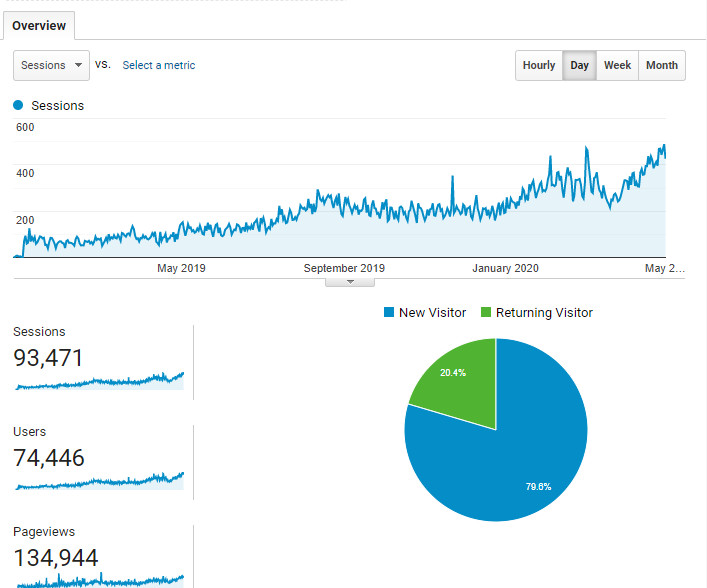If you are a blogger or small business owner looking for a way to increase your business’s revenue, then content marketing may be the answer.
Fact:
Companies that fail to create a comprehensive content marketing strategy may be losing out on future business.
Tip:
Companies should adopt multiple distribution channels for content to maximize return on investment (content marketing ROI).
In this blog post, we will discuss 12 steps that can help lead you in the right direction when creating a strategy for your content marketing strategy.
Table of Contents
Why you need a content marketing strategy?
With the current state of the internet, social media, and Google, content marketing is more important than ever.
It helps build trust in your brand while providing valuable info that will keep your viewers coming back.
- Content marketing is one of the most important strategies for any business because it helps you reach your goals – more traffic, more leads, and sales.
- Content strategy helps you track progress, and organizations of all sizes can benefit from utilizing a content marketing plan.
- Content marketing is an essential component of today’s digital marketing, and if your business isn’t implementing it, you’re losing out on opportunities.
- A content marketing strategy helps you cut costs by creating your own brand’s content while collaborating with agencies or companies to provide quality information on their topics.
- Content strategy optimizes your marketing team and helps you reach a bigger audience.
Creating a content marketing strategy for your business is one way to help you produce content that converts visitors to customers, but there are other things you can do, such as getting personal and amplifying your message across social media.
In a world where we are bombarded with data and information, people need to be able to quickly find what they’re looking for.
Bloggers are always looking for fresh content to share with their readers; it’s a way to build trust and authority within an industry.
That’s why you need a content marketing strategy that will help your company grow!
What is a content marketing strategy?
A content marketing strategy is a plan for how you will distribute your specific type of information.
This may include things like:
- What to write about
- Who should see it and
- Where the posts can be published
- Examples are: on social media, your website or blog or YouTube.
It’s important that any potential readers are reading something they find interesting – not just any content – so you must be specific with your target audience.
Who is your target audience
A question that is often asked by entrepreneurs and bloggers is, “Who am I writing for?”
It’s a difficult question to answer because it can be interpreted in so many different ways.
Bloggers may want to write for themselves, or they might have a specific audience in mind, such as their
- Newbeginners at blogging who need advice
- Work colleagues
- Friends
- Family members
- People living in another country
Some will even write posts specifically targeting the blogosphere and other bloggers.
Of how they made a successful blog so others may follow their path.
Know your audience
If you want to be successful with your content marketing, it’s important to know your audience.
This is why Page1 Clients has put together this post for bloggers.
We hope that by the end of this post, you will have a better understanding of what makes your audience tick and how best to engage them on social media channels like Facebook and Twitter.
The important thing to remember is that the target audience should dictate what type of content will be most appealing.
This could include things like how technical you are allowed or willing, writing in a conversational tone rather than strictly informative and authoritative, whether your goal for blogging includes making money from advertising.
Step 1: Define your goals
The first step in creating a content marketing strategy is to set some goals for your campaign.
The goal of a content marketing strategy is to reach your target audience with valuable, timely information.
To do so, you will need the following:
- An understanding of who you are as a brand and what makes it special
- A comprehensive list of goals for each project you embark on
- The initiatives that will yield the best results
How do I measure success with each goal (ease-of course of action)
A good starting point for your content marketing strategy is creating a mission statement for your business.
This is a brief statement that makes it easier to focus on what’s important – and what’s not – it’s important to keep your content strategy on track.
A content marketing strategy could describe:
For your content marketing strategy to work, you need a focused audience.
- Who are they?
- The content you’ll use to reach them are?
- The benefits they’ll get when interacting with your content?
To create a mission for your own business, try this formula:
We have a customizable platform that provides [target audience] with the content they need to help them [business goals].
Although you should always have a mission statement for your marketing strategy, the idea doesn’t stop there. You also need to understand what your business will get from it.
One of the most important parts of your business marketing strategy is formulating goals.
The steps below can be applied to any type of content marketing, but they are most applicable for B2B brands and agencies that need their audience or customers to identify with their brand message.
Typical goals include:
- Improving revenue as a result of your content marketing strategy
- Making more sales and getting more high-quality leads, which will help you meet your revenue goals.
- Getting more traffic to your site, as the more traffic, there is, the greater the possibilities for meeting your other goals.
- You are improving the perception of your business so you gain influence and authority and are seen as a thought leader.
- SEO success, which leads to more traffic.
- Reduced marketing costs as your content becomes more effective.
- Social media engagement, which can help with both traffic and authority.
Once you know your goals, it’s time to move to the next step.
Step 2. Create key performance indicators
The best way to create a content marketing strategy is to make it specific with key performance indicators (KPIs). The KPIs will help you know when you have achieved your goals by providing milestones you can check off.
They’ll include what you plan to achieve in terms of
- Total revenue
- Sales
- Traffic
- Search engine optimization SEO
- Traffic and different aspects of digital marketing like email marketing and social media metrics.
Content marketing recommendations typically have numbers attached to the various metrics.
For example, you might want to:
Hit your target revenue volume. Per month, per year.
If you want to hit your target revenue volume, make sure that you have the right tools.
Get more signups for your lead magnet as a sign that you’re getting more high-quality leads.
TIP: When they sign up, what matters is how good of quality the leads seem to be in order find out if there will be any worth following through with as customers and making more sales from them
Get new email subscribers. The only way you can grow your business is through acquiring more customers and increasing the number of people who are interested in what you have to offer them, which comes down mainly just one thing – generating leads.
See a jump in site traffic and greater customer engagement with your blog content.
You might be surprised how much of a difference it can make to your brand’s SEO when you post engaging content regularly.
Improve the search engine rankings of some of your key pages to help boost organic traffic.
TIP: Keyword research is a vital part of your content marketing strategy and can be used to help you decide on the best topics for future posts.
Get your most important pillar content the attention it deserves! Get a certain number of mentions, shares and comments for each piece to get noticed.
Be invited to participate in certain key industry events.
You’ll also want to pay attention to marketing expenditure, tracking your spending on different campaigns and keeping an eye on the cost of acquiring leads and making sales.
There are many ways you can save money while still competing in a tough marketplace, such as outsource SEO services or Free SEO tools.
Step 3. Know who you are writing to
In order for your content marketing strategy to be successful, you’ll need to be clear about who the business’ audience is.
There are three actions you need to take.
Collect Demographic Data
The first step in creating a content marketing strategy for your business is to survey your current customers.
Web analytics, social media analytics, and email subscriber analytics will show you the data on your audiences’
- Age
- Gender
- Education level
- Annual Income
Furthermore, you’ll get an understanding of what they’re interested in.
To find this information in Google Analytics, go to Audience » Interests » Overview. You’ll see the different markets your customers fit into.
The data available on social media sites is similar. For instance, you can get demographic information on your Facebook fans via the Page
Insights tab.:
And you can use Twitter Analytics to learn more about your followers:
Get Customer Feedback
To learn more about your target audience, ask for feedback from current customers.
That’ll give you insights into:
- How do they feel about the content you’re producing currently)
- The needs of your customers
- How you can help their problems with your content
- Getting the right customer feedback can help you:
- Understand and research what your readers want
- Determine the best places to reach your customers (see step 9)
To create a content marketing strategy, you need to flesh out your buyer personas.
Here’s our key steps to help you develop a strategy for collecting feedback from your site’s visitors.
Create Buyer Personas
It is important to create buyer personas so that you can target your content marketing efforts.
Get customer feedback, demographic data and create or flesh out your buyer personas. One of the best ways to create a content marketing strategy is by determining your buyer personas.
The best customer avatars include their specific pain points, challenges, informational sources, and motivating factors.
When you know all this, you will have a better understanding of:
- The kind of content that will grab your audience’s attention.
- How it will help them with whatever it is that you’re offering
- Creating content people care about
To learn more about developing your buyer personas, see this guide. It includes templates like this one from Digital Marketer:
Share This Story







